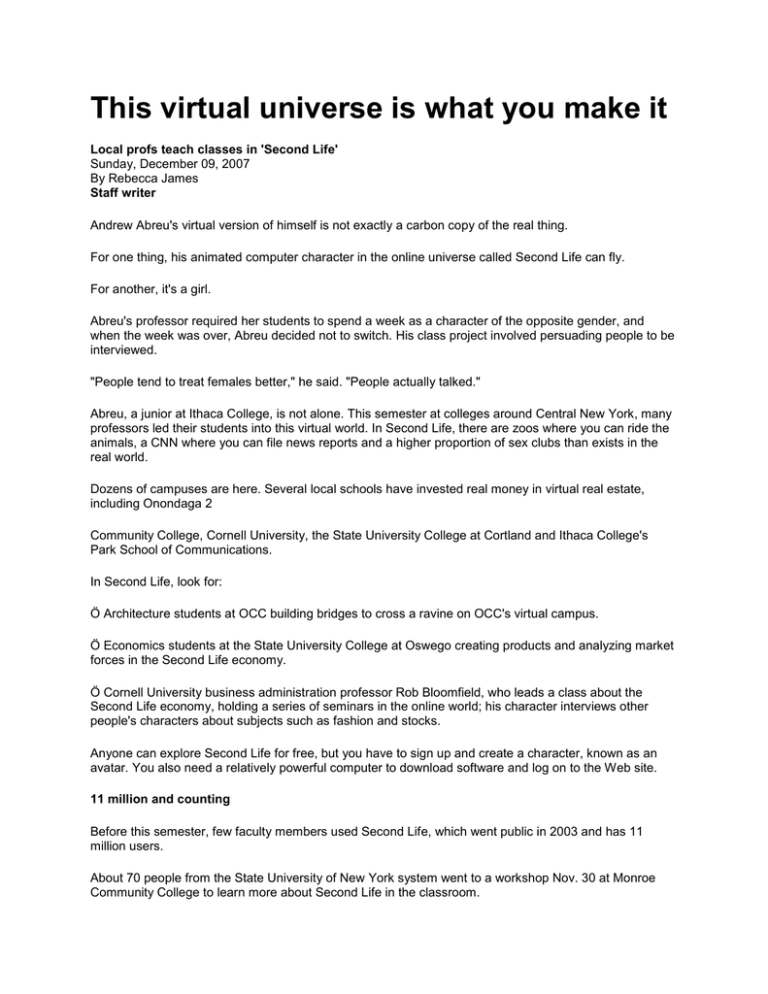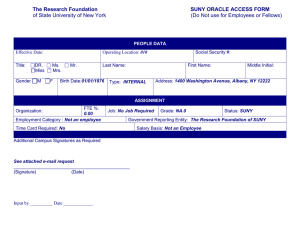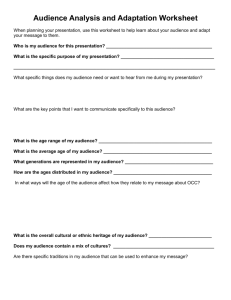
This virtual universe is what you make it
Local profs teach classes in 'Second Life'
Sunday, December 09, 2007
By Rebecca James
Staff writer
Andrew Abreu's virtual version of himself is not exactly a carbon copy of the real thing.
For one thing, his animated computer character in the online universe called Second Life can fly.
For another, it's a girl.
Abreu's professor required her students to spend a week as a character of the opposite gender, and
when the week was over, Abreu decided not to switch. His class project involved persuading people to be
interviewed.
"People tend to treat females better," he said. "People actually talked."
Abreu, a junior at Ithaca College, is not alone. This semester at colleges around Central New York, many
professors led their students into this virtual world. In Second Life, there are zoos where you can ride the
animals, a CNN where you can file news reports and a higher proportion of sex clubs than exists in the
real world.
Dozens of campuses are here. Several local schools have invested real money in virtual real estate,
including Onondaga 2
Community College, Cornell University, the State University College at Cortland and Ithaca College's
Park School of Communications.
In Second Life, look for:
Ö Architecture students at OCC building bridges to cross a ravine on OCC's virtual campus.
Ö Economics students at the State University College at Oswego creating products and analyzing market
forces in the Second Life economy.
Ö Cornell University business administration professor Rob Bloomfield, who leads a class about the
Second Life economy, holding a series of seminars in the online world; his character interviews other
people's characters about subjects such as fashion and stocks.
Anyone can explore Second Life for free, but you have to sign up and create a character, known as an
avatar. You also need a relatively powerful computer to download software and log on to the Web site.
11 million and counting
Before this semester, few faculty members used Second Life, which went public in 2003 and has 11
million users.
About 70 people from the State University of New York system went to a workshop Nov. 30 at Monroe
Community College to learn more about Second Life in the classroom.
They heard how students in Buffalo designed clothing for a fashion show in Second Life and students in
Oneonta organized and marketed live music events.
Monroe Community College received a $7,000 grant from SUNY to provide two hands-on workshops. In
May, 54 people from more than 20 campuses came to the first workshop. Afterward, the group met
weekly in Second Life to exchange ideas about teaching there.
"We've proven that there is a sustainable group that has a strong interest in Second Life," said Terry
Keys, director of instructional technologies at Monroe Community College, who helped organize the
workshops.
"We've seen a lot of campuses around the country and the world use it," he said. "It's not an end all and
be all, but it is a tool that can be used to improve education."
OCC and SUNY Cortland are doing pilot projects in Second Life in the 2007-08 academic year.
Professors and administrators offer office hours in Second Life, hold presentations there and create
spaces where small groups of students can meet.
At OCC, one class required the use of Second Life: the architecture and design class that built virtual
bridges there. Other faculty members offered Second Life extra-credit projects.
More faculty members plan to try it in the spring, including the chair of the modern languages department,
who plans to use it in an Italian class, said Pam Youngs-Maher, director of online learning at OCC.
Second Life recently added voice capability, which means students will be able to work on their
pronunciation. And since American users are a minority in the Second Life community, students could
meet native speakers of other languages around the world.
Buy land, have a meeting
Communication in Second Life is usually text-based, similar to instant messaging, but educators like the
fact that it provides common meeting spaces. Moving your avatar around and seeing other people's
avatars is more engaging than a conference call or just reading lines of text on a screen.
"If I had to sit in front of my computer, trying to follow a chat conversation for an hour, I'd get very
distracted," Youngs-Maher said. "This makes it a visual experience, and the hour flies by."
That sort of engagement can be missing for students taking classes online, which is increasingly common
for students on and off campus.
"We offer six online degrees, and we really want to make it more of a visual and audio medium for our
students," Youngs-Maher said.
In the summer, SUNY Cortland spent about $1,000 to buy an island in Second Life. Alex Reid, associate
professor of English, is using it in two writing classes.
The students in Reid's online class "Writing in the Digital Age" created avatars and met with students from
other countries to create a flag and work on building projects in Second Life. As a final project, students
created a slide presentation, synchronized with recorded audio, to describe the experience.
As computer-based worlds go, Second Life is easier to figure out than many others, said Hamilton
College anthropology professor Douglas Raybeck.
"Students can walk in cold and within a week, they are up and running," he said. "Most systems require
too steep a learning curve. They only have a semester; you don't want to spend it on computer principles,
unless you're teaching a computer class."
Raybeck introduced an upper-level seminar class to Second Life in spring 2006. Students in the "cultural
simulation" class created and ran a community set 75 years in the future; they devised and designed
everything, including buildings and a government structure.
Hamilton rented an island in Second Life for the project, and only those in the class had access to it.
Kim Gregson, an assistant professor in Ithaca College's Park School of Communications, is a Second Life
pioneer. She brought students into it in spring 2005. Her students have done projects looking at religion in
Second Life and at intellectual property in virtual worlds.
She also uses Second Life in a media planning class in which students learn how to handle a $30 million
advertising budget by pitching products such as clothes and cars.
Get used to it
Second Life comes with its share of frustrations and technical challenges.
Not all students' computers, or even those in computer labs on campuses, are compatible with it. Some
say the graphics are clunky and the site sometimes crashes or is closed for maintenance.
Others object to the sexual content in Second Life. The menu for avatars offers the option to "take off
clothing," and the characters can have virtual sex.
But it's also the place where Vassar College built a scale model of the Sistine Chapel, offering users the
chance to explore Michelangelo's frescoes at close range.
Certainly, this virtual world has plenty of strip clubs and users who proposition unsuspecting avatars, but
Gregson said she hopes professors don't avoid Second Life because of the sexual content.
"It seems like a shame," she said. "Do they never take their students on the Web? Do they never leave
the classroom?"
So far, this is faculty introducing students to a new use of technology. While some students are familiar
with avatars and virtual worlds from games, few spend time in non-game virtual worlds.
This semester, SUNY Oswego economics professor John Kane gave a class of 470 students a choice of
projects, one of which was comparing product markets and labor in Second Life to the real world.
About 20 students chose that option, and only one had Second Life experience.
"I think it will be more common in four to five years," Kane said.
While not all college students visit virtual worlds, lots of elementary school children do, going online to join
communities and play games in places like Disney's Club Penguin.
Kane said, "Students who are growing up with that are going to be expecting virtual world experiences."
© 2007 The Post-Standard. Used with permission.
Copyright 2007 syracuse.com. All Rights Reserved.


